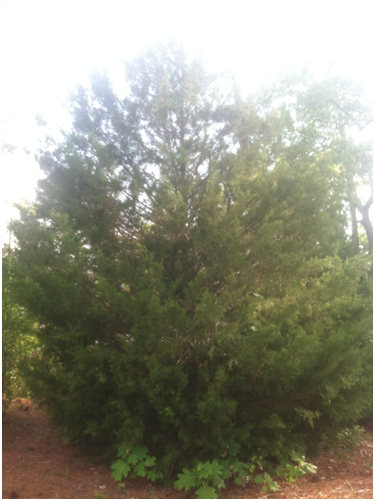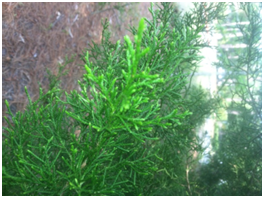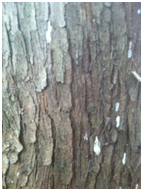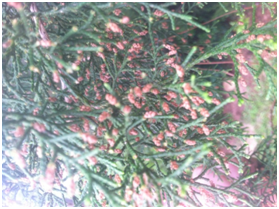Red Cedar
Juniperus virginiana

(Photo by Logan Petrey)
View the Location on Campus
Taxonomy (1)
Classification: Gymnosperm
Family: Cupressaceae
Common name: Red Cedar
General Information (1)
Region of Origin: Eastern North America and southeastern Canada
USDA Plants Hardiness Zones: 3-9
Growth Habit: Tree
- Size: 40-60 feet tall
- Deciduous/Evergreen: Evergreen
- Cones: September-October
- Other: Dioecious
Diagnostic Characteristics
Leaves (2)
- Arrangement: Opposite
- Simple/Compound: Simple
- Shape: Needle (young); Scale (mature)

(Photo by Logan Petrey)
Stem/Bark (2)
- Color: Grayish to reddish
- Texture: Fibrous

(Photo by Logan Petrey)
Female cone (2)
- Shape: Berry-like
- Color: Blue
- Texture: Leathery
Male cone (2)
- Texture: Papery
- Color: Yellow-brown

(Photo by Logan Petrey)
Horticultural Information (1)
- Light: Full sun to shade
- pH: Basic
- Maintenance: Easy to care for
- Landscape Uses: Shade tree
- Other: Avoid dry and acidic regions, and do not plant near apple orchards as it is a host for Cedar-Apple rust.
Interesting Facts (1)
- Red cedar wood is used to make fences posts and pencils.
- The oil from the seed cones of Juniper trees are used to flavor gin.
- Native Americans used the wood of red cedar for bows.
References
- Christman, S. (2012). Juniperus virginiana. Retrieved from http://www.floridata.com/ref/J/Juniperus_virginiana.cfm
- United States Department of Agriculture (n.d.). Eastern Red Cedar. Retrieved from http://plants.usda.gov/plantguide/pdf/cs_juvi.pdf
Prepared by Logan Petrey as a course requirement for BIOL 3630/5630, Spring 2013
Edited by Jessica Bartek
Edited by Jessica Bartek
Department of Biology
-
Room 2035, 2nd Floor
Bailey Science Building -
Mailing Address
1500 N. Patterson St.
Valdosta, GA 31698 - Phone: 229.333.5759
- Fax: 229.245.6585
Monday - Thursday
8:00AM until 5:30PM
Friday
8:00AM until 3:00PM
Saturday - Sunday
Office Closed